The Fender Stratocaster and Fender Telecaster are two incredibly iconic electric guitars, but what exactly are the differences between them? And which is the best option for you? In this article I’ll be directly comparing these two electric guitar models and highlighting all the differences and similarities so you can decide which to choose.
Stratocasters sound cleaner and brighter compared to Telecasters sound warmer and fuller with more grit and bite. Stratocasters have an additional cutaway, extra pickup, and extra tone control compared to Telecasters. Stratocasters also have a tremolo bridge whereas Telecasters have a fixed bridge.
| Stratocaster | Telecaster |
| Sounds cleaner and brighter | Sounds more gritty and warmer |
| Has 3 Pickups | Has 2 Pickups |
| Has a 5-Way Pickup Selector | Has a 3-Way Pickup Selector |
| Has two tone controls | Has one tone control |
| Double-cutaway, contoured body | Single cutaway, flat body |
| Synchronised tremolo bridge | Fixed string-through bridge |
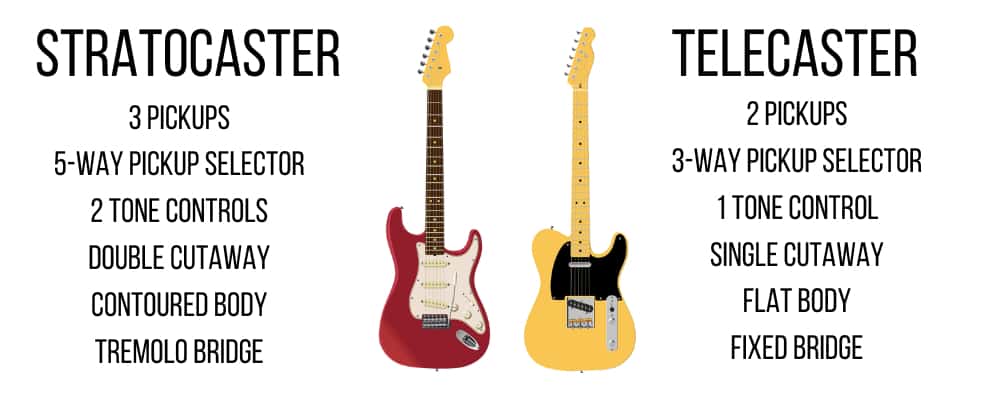
Tone Difference
Stratocasters sound brighter, cleaner and clearer in comparison to Telecasters which sound slightly darker but with more bite and grit. The difference is not huge, and in a mix it can sometimes be difficult to hear especially to untrained ears, but these guitars definitely do have a slightly different tonal character.
Check out this tone comparison between a Fender Stratocaster and Telecaster.
So why do these two guitars actually sound different despite having the same type of pickups? Well there are actually several reasons why this is the case.
The Strat of course has three pickups, whereas the Tele only has two. The positioning of the pickup affects the tone, with the bridge pickup sounding brightest and hottest, and the neck pickup sounding warmest and cleanest. Having that extra middle pickup on a Strat does give you some more tones to play with.
The pickups themselves also have several structural differences.
| Telecaster Pickups | Stratocaster Pickups |
| More coil windings which leads to increased output resulting in a grittier tone | Fewer coil windings which means the output of the pickup is lower and the tone is cleaner |
| The bridge pickup is mounted on a metal plate which boosts the bass and low-mid frequencies and creates more twang | The bridge pickup is mounted on plastic which means it sounds cleaner with less snap and twang |
| Telecaster neck pickups use thinner wire which results in a darker tone | Stratocaster neck pickups use thicker wire which results in a brighter tone |
| The metal cover on the Telecaster neck pickup reduces the high-end frequencies, leading to a slightly warmer and darker sound compare | Stratocaster pickups are all uncovered which results in more top end clarity, but also more feedback |
Music Style Suitability
Both guitars are versatile and can be used for a wide range of music styles however the Telecaster typically is considered to be the most versatile.
The Telecaster has some extra bite on the bridge pickup, which means it has more punch and cut when using high gain. However, it also produces great twangy clean tones for country music. Although Telecasters are not synonymous with styles like jazz, they tend to suit it more compared to Stratocasters as they sound a bit warmer on the neck pickup.
Stratocasters are still used in many different music genres though, and are typically used for blues, rock ‘n’ roll, and funk more than Telecasters.
It’s rare to see either the Telecaster or Stratocaster in heavy metal, as the single coil pickups produce a lot of feedback and noise when using distortion. It is possible to get humbucker versions of both these guitars which makes them more suitable for very high-gain genres though.
| Music Style | Most Popular Choice |
| Hard Rock | Telecaster |
| Metal | Telecaster |
| Country | Telecaster |
| Jazz | Telecaster |
| Rock ‘n’ Roll | Stratocaster |
| Blues | Stratocaster |
| Funk | Stratocaster |
| Punk | Stratocaster |
There are no rules here though, and there are loads of examples of both guitars being used in every style of music, so I’d highly suggest just picking the one you prefer the sound of.
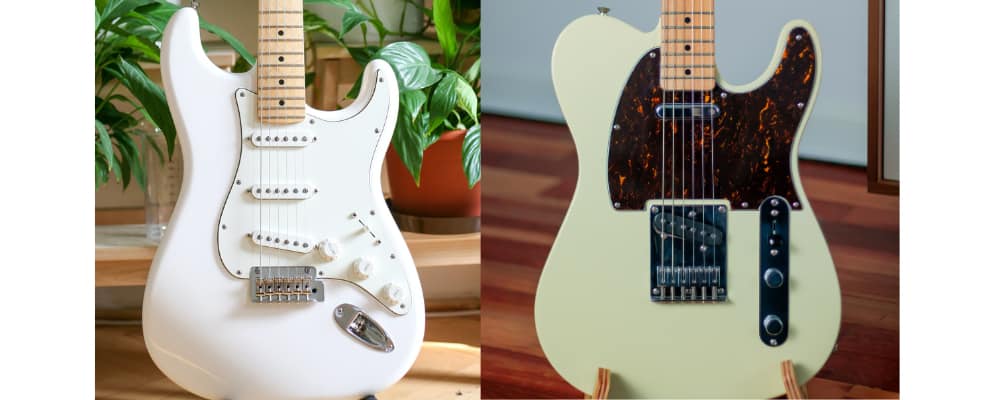
Controls
The controls on these guitars are different from one another.
- Stratocasters have two tone controls whereas Telecasters only have one tone control. Both guitars have one master volume control.
- Stratocasters have a 5-way pickup selector whereas Telecasters have a 3-way pickup selector
These differences are because the Strat has three pickups and the Tele only has two.
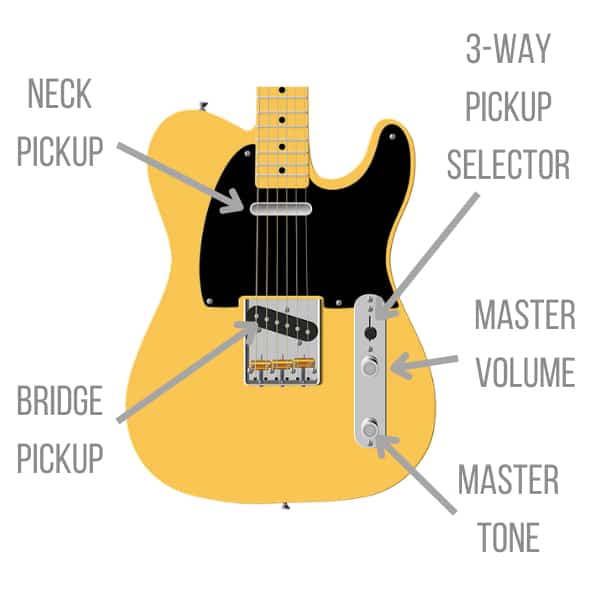
On a Tele, you just get a master volume and a master tone control that adjusts both pickups.
You can then use the 3-way pickup selector to either activate the bridge or neck pickups in isolation or in combination.
Check out this Tele control guide to learn more.
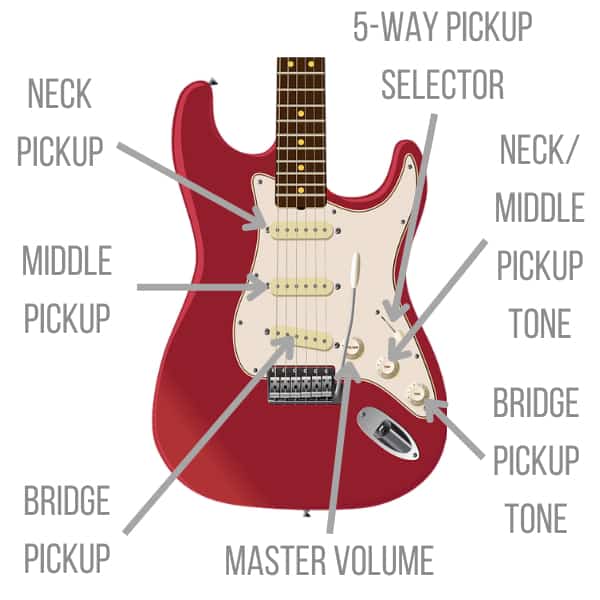
On a Strat, you can use the 5-way pickup selector to either activate any of the pickups in isolation, or the bridge or neck pickup in combination with the middle pickup.
The first tone control adjusts the middle and neck pickups, and the second tone control adjusts the bridge pickup.
Check out this Strat control guide to learn more.
Although the Strat has more controls, it’s still easy to get the hang of even if you are a complete beginner. There is also the argument that the extra pickup and controls on the Strat give it some more versatility and allow you to easily adjust the tone on the go, without having to adjust the amp or use pedals mid-song.
However, despite the Tele only having a master tone, master volume and 3-way pickup selector, I think it’s still really easy to get different tones out of it and it’s a very versatile guitar in my opinion.
Body Shape
The Stratocaster and Telecaster also have very different body shapes which affects how they feel to play:
- Strat have a double-cutaway body whereas Teles have a single-cutaway body
- Strats have a contour on the lower bout (called an elbow cut) unlike Telecasters which have a flat top
- Strat have contouring on the back of the body whereas Teles have a flat back
- Strats have a rounded edge cut whereas Teles have a harder edge
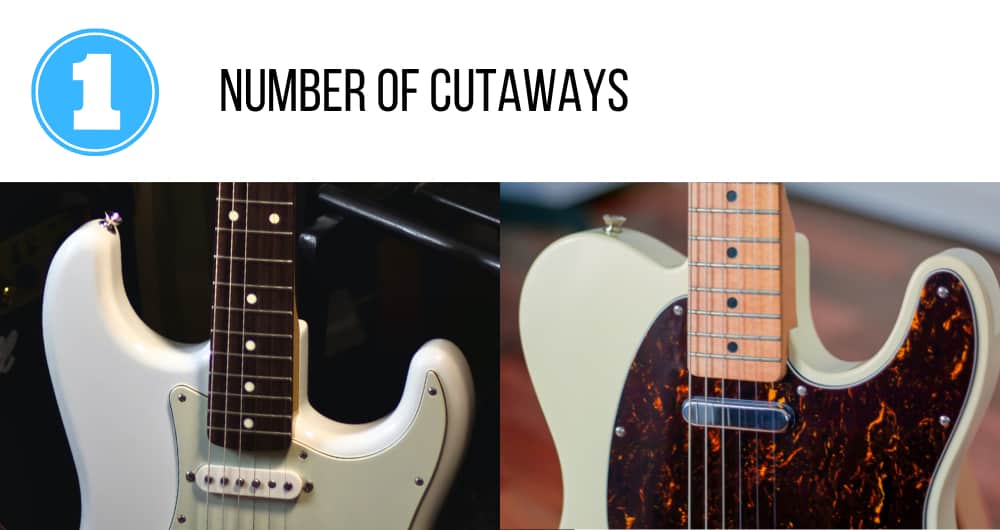
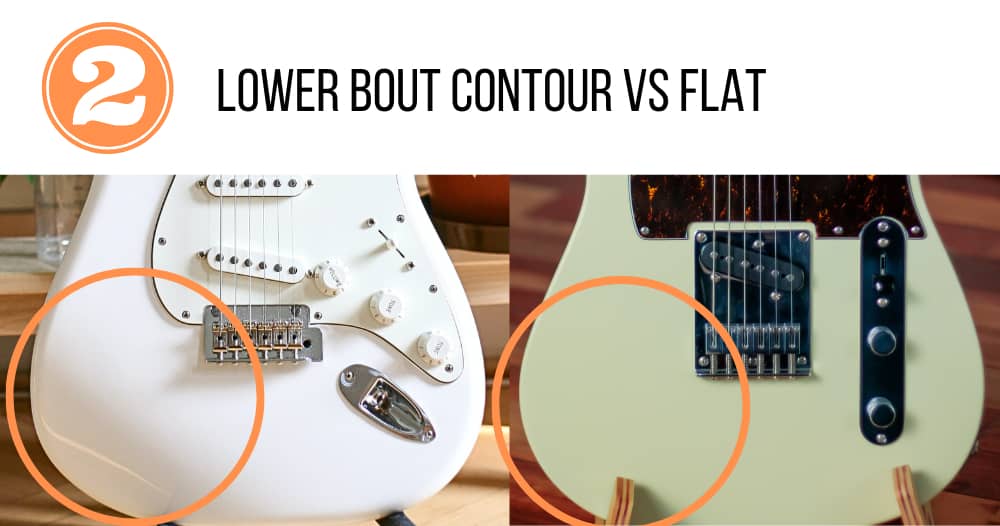
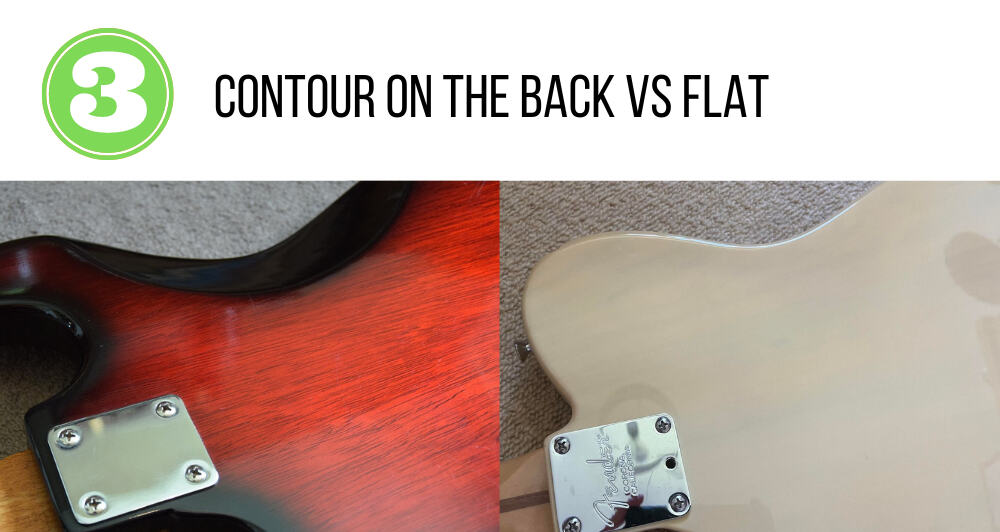
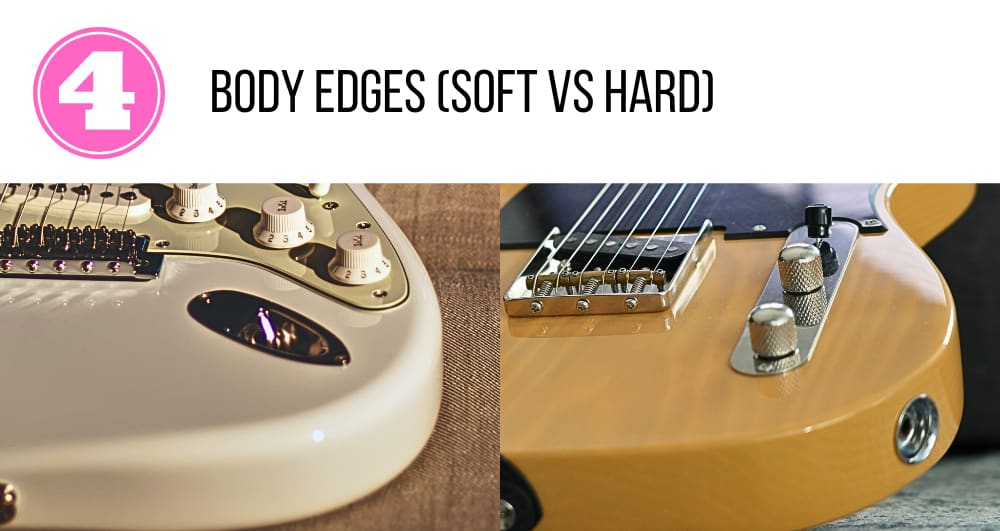
The Stratocaster definitely feels more comfortable to play with compared to the Telecaster. The contours and rounded edges feel more comfortable when sitting and standing, and the additional cutaway helps increase access to the upper frets.
There are a few Tele models though with additional features designed to improve comfort including the Fender Player Plus, American Ultra and American Ultra Luxe Telecaster which feature contour on the back (similar to the Strat).
The body dimensions of the Strat and Tele are very similar.
| Dimension | Stratocaster | Telecaster |
| Body Length | 17.4″ | 17.0″ |
| Lower bout width (widest point) | 12.75″ | 12.75″ |
| Maximum Depth | 1.72″ | 1.75″ |
Since the Stratocaster has an extra cutaway and more contouring, but also heavier hardware, these two guitars typically weigh the same.
- On average Fender Stratocaster and Telecaster electric guitars weigh 7-8 lbs
- On average Squier Stratocaster and Telecaster electric guitars weigh 6.5-7.5 lbs
Bridge
Another key difference between these two electric guitar models is the bridge design:
- Fender Stratocasters have a synchronised tremolo bridge
- Fender Telecasters have a string-through body bridge
The bridge designs on both models can vary slightly (e.g. the number of saddles, material etc.) depending on the exact model, but the basic bridge type (synchronised tremolo vs is the same for pretty much every Strat and Tele.
Telecaster Bridge (String-Through)
Telecaster have a string-through bridge design which means the strings are pulled through the body of the guitar. They have either 3 saddles (a saddle for every 2 strings) or 6 saddles (a saddle for each individual string), depending on the exact model.
This Tele bridge design helps to give the guitar plenty of sustain and also that twangy character. It’s a simplistic system which makes it easy to change the strings and doesn’t really have any bells or whistles.
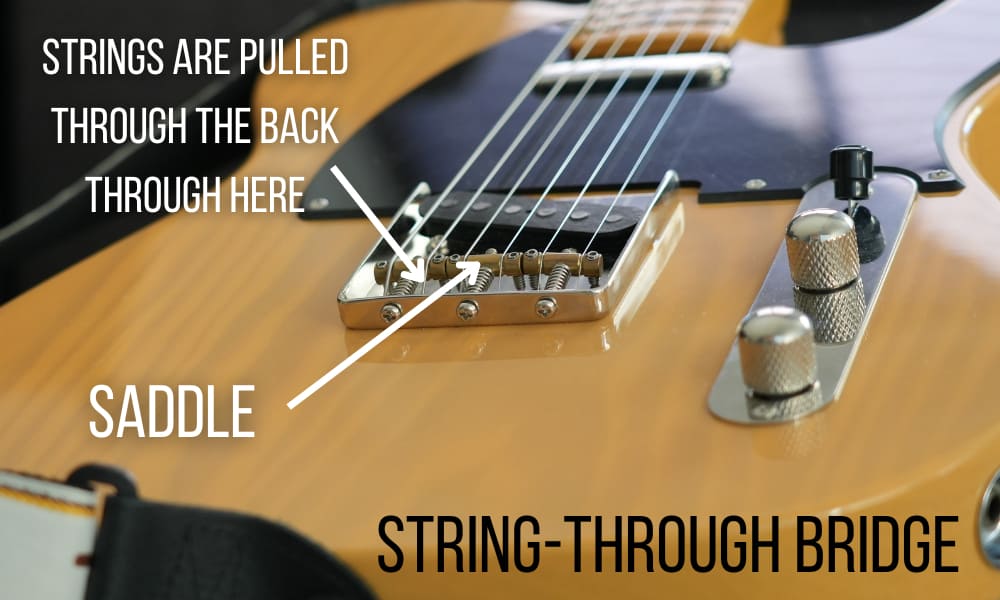
Stratocaster Bridge (Synchronised Tremolo)
The Stratocaster on the other hand is more complex and has a synchronised tremolo bridge design. Here’s a quick explanation of how it works:
- Attaches to the body using either 2 or 6 screws.
- The saddle positions are altered individually by screws on the back to adjust the intonation.
- The height of the bridge is adjusted using the screws on the side allowing the action to be adjusted.
- The strings go through to the sustain block in the cavity of the guitar and come out of the holes in the saddle.
- The tension of the strings is controlled by the strings in the cavity.
The benefit of a tremolo bridge is that you get a tremolo arm, which is used to change the pitch and create some really cool effects which you can’t do on a Telecaster. However, it does result in less tuning stability and makes changing the strings a bit more difficult.
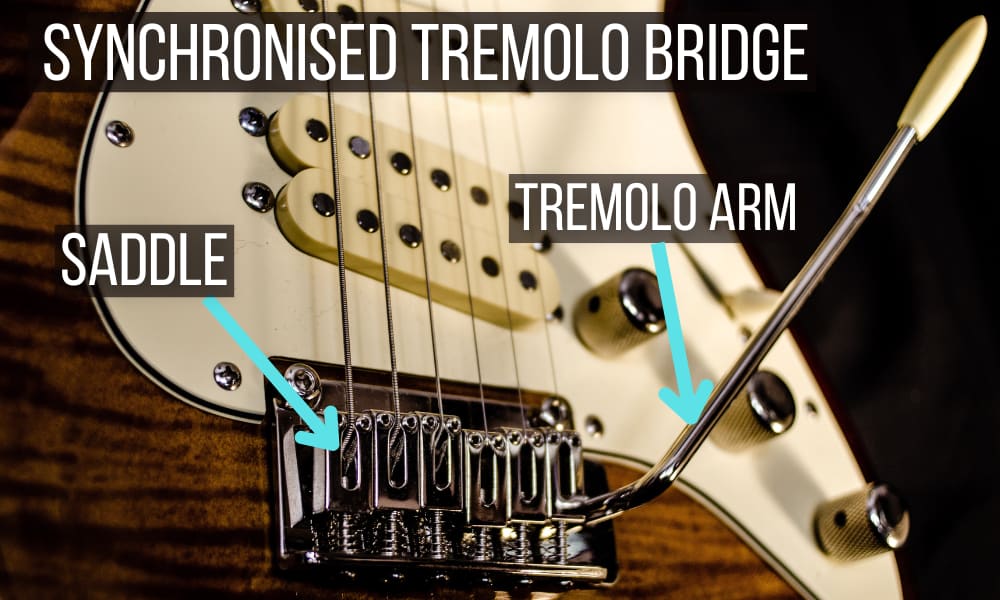
Neck Shape and Size
Fender and Squier have organised their ranges into different series (e.g Player, American Performer, American Professional etc.) which differ by price and some specifications. These series all include Stratocaster and Telecaster models.
All Strat and Tele models in the same series have the same neck profile, depth, nut/ fretboard width, fret size, and fingerboard radius, so the necks feel identical to play.
The only exceptions are the models in the Fender American Original, American Vintage II and Vintera series. In this cases, the Strat and Tele models have different neck designs. On the ’50s versions of these guitars you’ll find a V-shape neck on the Stratocasters and U-shape neck on the Telecasters which feels much fuller in the hand.
Here is a table showing all the different models available and their specifications. Note: you will need to either scroll across or turn your device horizontally if viewing on a smaller screen.
Series with the Same Stratocaster and Telecaster Specifications
| Series | Neck Profile | Neck Depth (1st-12th Fret) | Fingerboard Radius | Nut Width | Fret Size |
| Squier Bullet | C-Shape | 0.83-0.91” | 9.5” | 1.65” | Medium Jumbo |
| Squier Sonic | C-Shape | 0.83-0.91” | 9.5” | 1.65” | Narrow Tall |
| Squier Affinity | C-Shape | 0.83-0.91” | 9.5” | 1.65” | Medium Jumbo |
| Squier Classic Vibe | C-Shape | 0.83-0.91” | 9.5” | 1.65” | Narrow Tall |
| Squier Contemporary | C-Shape | 0.83-0.91” | 12” | 1.65” | Jumbo |
| Fender Player | Modern C | 0.83-0.91” | 9.5” | 1.65” | Medium Jumbo |
| Fender Vintera Modified | Modern C | 0.83-0.91” | 9.5” | 1.65” | Medium Jumbo |
| Fender Player Plus | Modern C | 0.83-0.91” | 12” | 1.685” | Medium Jumbo |
| Fender American Performer | Modern C | 0.83-0.91” | 9.5” | 1.685” | Jumbo |
| Fender American Professional II | Deep C | 0.84”-0.92” | 9.5” | 1.685” | Narrow Tall |
| Fender American Ultra | Modern D | 0.83”-0.87” | 10”-14” | 1.685” | Medium Jumbo |
| Fender American Ultra Luxe | Augmented D | 0.83”-0.89” | 10”-14” | 1.685” | Medium Jumbo |
Series with Different Stratocaster and Telecaster Specifications
The following guitars all have a 1.65″ nut width and vintage frets.
| Series | Neck Profile | Neck Depth (1st-12th Fret) | Fingerboard Radius |
| Fender Vintera ‘50s Stratocaster | Soft V | 0.91″-1.00″ | 7.25” |
| Fender Vintera ‘60s Stratocaster | Mid ‘60s C | 0.83”-0.97” | 7.25” |
| Fender Vintera ‘50s Telecaster | Early ‘50s U | 0.92”-0.99” | 7.25” |
| Fender American Original ‘50s Stratocaster | Soft V | 0.91”-1.00” | 9.5” |
| Fender American Original ‘60s Stratocaster | Thick C | 0.84”-0.97” | 9.5” |
| Fender American Original ‘50s Telecaster | 1952 U | 0.94”-1.00” | 9.5” |
| Fender American Original ‘60s Telecaster | ‘60s C | 0.83”-0.97” | 9.5” |
| Fender American Vintage II 1957 Stratocaster | 1957 V | 0.89”-0.99” | 7.25” |
| Fender American Vintage II 1961 Stratocaster | 1961 C | 0.82”-0.93” | 7.25” |
| Fender American Vintage II 1973 Stratocaster | 1973 C | 0.85”-0.91” | 7.25” |
| Fender American Vintage II 1951 Telecaster | 1951 U | 0.89”-1.00” | 7.25” |
| Fender American 1963 Vintage II | 1963 C | 0.83”-0.98” | 7.25” |
Check out my complete guide to Fender neck profiles for more information on the specifications.
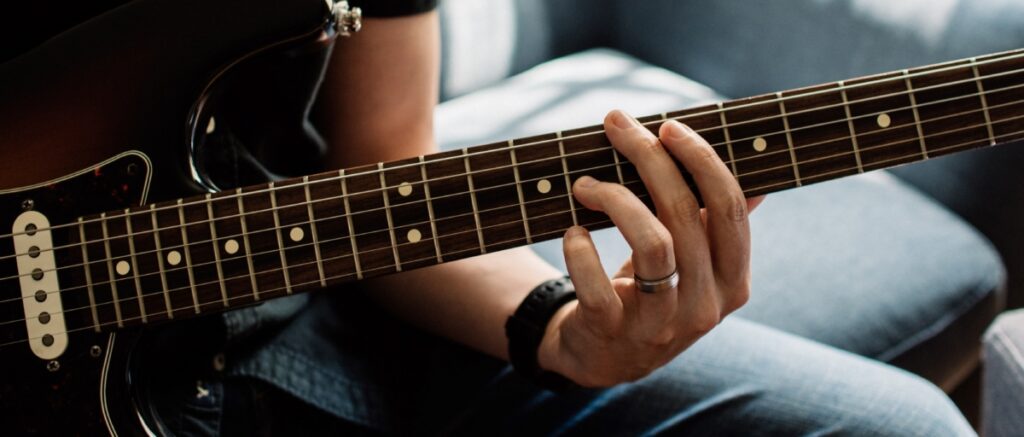
Similarities
Both the Telecaster and Stratocaster share the following features:
- 25.5″ scale length
- 22 frets (21 frets on vintage models)
- Alder body wood (ash body on vintage models)
- Maple neck
- Bolt-on neck construction
- 6 in-line headstock design (although Telecasters do have slightly smaller headstocks)
Strats and Teles within the same series (e.g. Player, American Professional II etc.) also share the same features:
- Neck profile
- Fingerboard radius
- Nut width
- Fretboard wood
- Fret size (e.g. medium jumbo, narrow tall etc.)
- Body finish (nitro or poly)
- Neck finish (gloss or satin)
- Truss rod nut
- Tuning machines
- Gig bags/ cases
- String gauges
- Nut material (e.g. bone)
- Hardware finish
Price and Options
The price of comparable Telecaster and Stratocaster models is the same.
As I’ve mentioned previously in this article, there are several different versions of the Fender and Squier Stratocaster and Telecaster which are designed to suit different budgets. Here is a list of all the standard models available and the prices.
| Stratocaster/ Telecaster Model | Average Price |
| Fender American Ultra Luxe | $2600 |
| Fender American Vintage II | $2100 |
| Fender American Ultra | $2100 |
| Fender American Original | $2100 |
| Fender American Professional II | $1700 |
| Fender American Performer | $1450 |
| Fender Vintera | $1100 |
| Fender Player Plus | $1100 |
| Fender Player | $800 |
| Squier Classic Vibe | $430 |
| Squier Affinity | $250 |
| Squier Bullet | $200 |
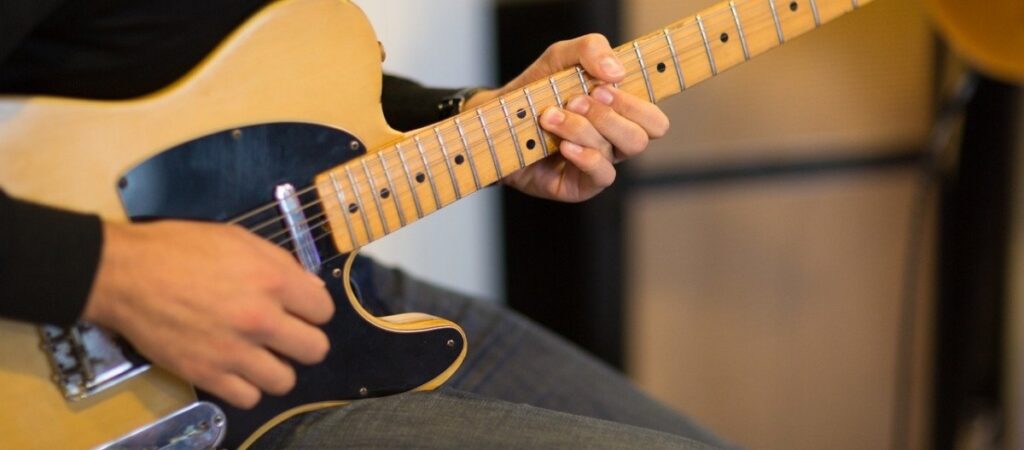
Which Guitarists Play Them?
Here is a list of famous electric guitarists who use either a Fender Strat or Tele.
Guitarists who Play a Fender Stratocaster:
- Jimi Hendrix
- Eric Clapton
- Stevie Ray Vaughan
- David Gilmour
- Mark Knopfler
- Jeff Beck
- Richie Blackmore
- Eric Johnson
- Tom Morello
Guitarists who use a Fender Telecaster:
- Keith Richards
- Brad Paisley
- Jimmy Page
- Jim Root
- Chris Shiflett
- Jonny Greenwood
- Bruce Springsteen
- James Burton
- Muddy Waters
Which Guitar Should You Choose?
You really can’t go wrong with either of these two guitars, so think about your answers to the following questions:
- Which do you prefer the tone of?
- Which do you prefer the look of?
- What do your guitar inspirations play?
- Do you want a simple Tele with an easy bridge and fuss-free controls? Or do you want more controls and a tremolo arm which you’ll find on the Strat?
I’d highly recommend that you try both guitars in store to figure out which you really prefer.
Which is Best for Beginners?
Generally, the Stratocaster feels a bit more comfortable to play so some beginners will appreciate that. However, both guitars feel great to play and you can get the same necks on both of them, so I personally think you should choose the one you like the sound and look of the most.
Check out this article on the Strat vs Tele for beginners to learn more.
Here are some more articles you might find useful:
